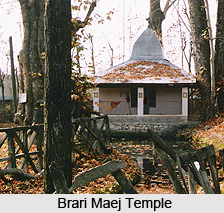 Brari Maej Temple is situated in the North West of the village in Mohalla Brarimaejpur which is in the district of Pulwama, Jammu and Kashmir. The word Brari has developed from "Bhattarika" meaning the venerated Mother. Brari Maej is synonymous to "Divine Mother Uma". This temple came into existence when the Bhat dynasty migrated from village Sumbal to this village in 1775. It is said that Adi Shankaracharya also spent some five years in a cave behind this temple while practicing different paths of God realization. The cave still exists in the temple.
Brari Maej Temple is situated in the North West of the village in Mohalla Brarimaejpur which is in the district of Pulwama, Jammu and Kashmir. The word Brari has developed from "Bhattarika" meaning the venerated Mother. Brari Maej is synonymous to "Divine Mother Uma". This temple came into existence when the Bhat dynasty migrated from village Sumbal to this village in 1775. It is said that Adi Shankaracharya also spent some five years in a cave behind this temple while practicing different paths of God realization. The cave still exists in the temple.
The beautiful temple of Brari Maej is surrounded by mighty chinars all around with a big and beautiful spring having crystal clear water. The temple is facing towards the east of the upper bank of the spring. Adjacent to the Brari Maej Temple is a Shivalaya dedicated to Lord Shiva. There are 2 Dharamshalas on the right side of the main entrance built for the accommodation of the pilgrims, wandering monks and priests.
Legend of Brari Maej Temple
The temple belongs to the Bhat Dynasty from Sumbal during the 18th Century. Sumbal is a small village in North Kashmir was the birthplace of the great-grand ancestors of the Bhat dynasty. This village used to be often submerged during the rainy season.
Pandit Bhawani Bhat (1760-1840), a pious and orthodox person, had a celestial dream, on Magha Ashtami. Divine Mother appeared in front of Pandit Bhawani Bhat and said that his great devotion has made her happy. The time has come to shift him from this place, as he has been facing a lot of hardships during the rainy season at Sumbal. Mother advised the king that early in the next morning, there will appear a cat in his compound. He was said to settle down with his belongings at the place where the cat indicates him to stay. That will be the next place of settlement of his 7 generations to live with dignity and honour, but his 8th generation will no longer stay there.
Early next morning, same thing happened as said by the Divine Mother and settled down at the location according to the Divine Cat"s indication. When the cat was gone, a small spring emerged on the spot. The spring was afterwards expanded by laying a single piece of stone and a temple was built on it. This was later called "Brari Maej" (Cat Mother) and an icon of the Divine Mother was installed by Shri Loket Bhat (1801-1876) in year 1875.











